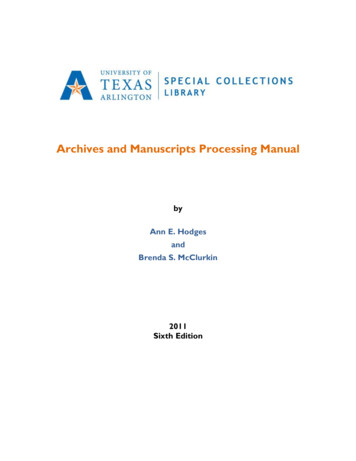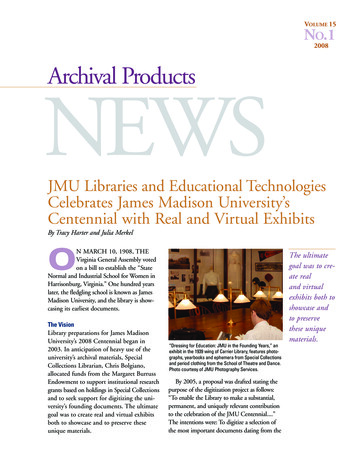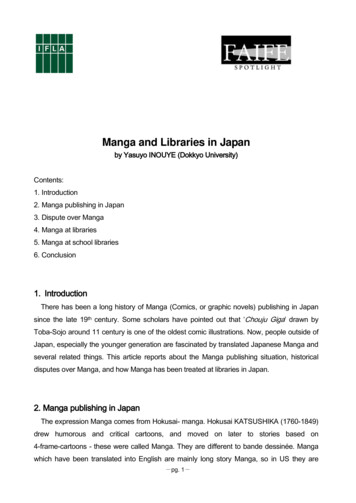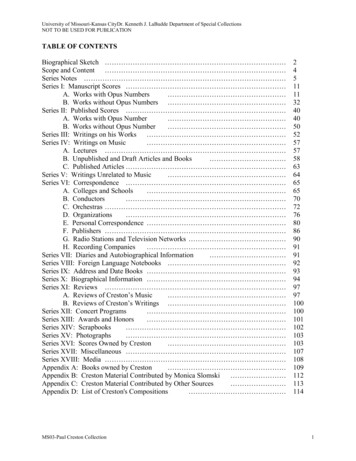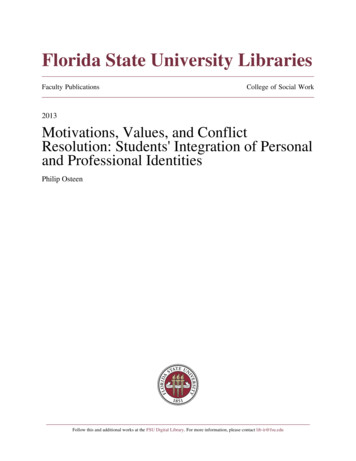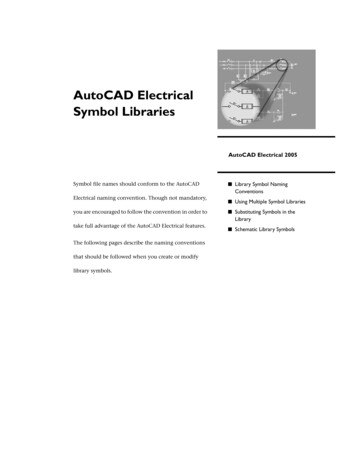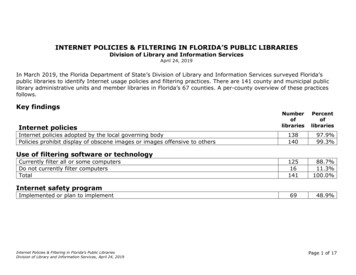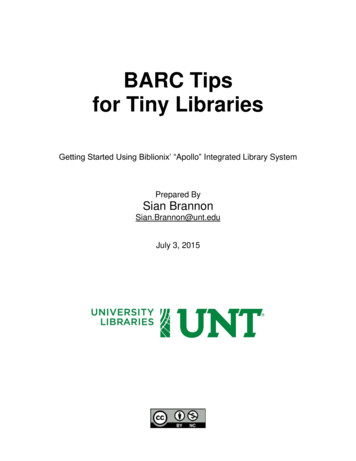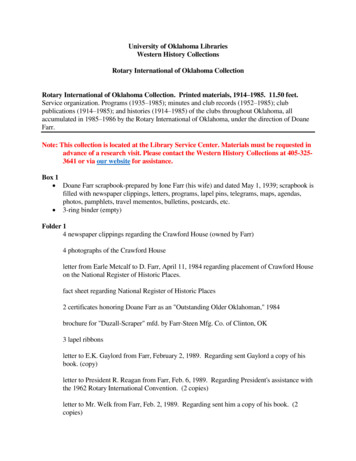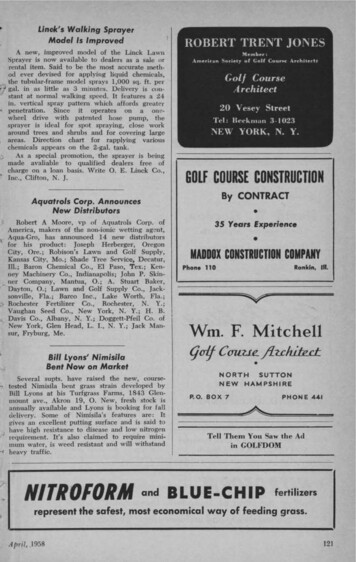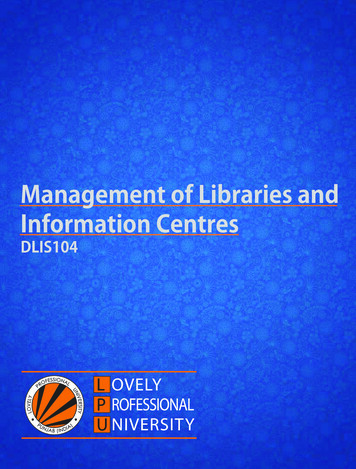
Transcription
Management of Libraries and Information CentresDLIS104
MANAGEMENT OF LIBRARIESAND INFORMATION CENTRES
Copyright 2012 Dr. MatheshAll rights reservedProduced & Printed byLAXMI PUBLICATIONS (P) LTD.113, Golden House, Daryaganj,New Delhi-110002forLovely Professional UniversityPhagwaraDLP-7751-044-MGMT LIB & INFO CENTRESTypeset at: Shubham Composers, DelhiC-4660/012/01Printed at: Sanjay Printers & Publishers, Delhi
SYLLABUSManagement of Libraries and Information CentresObjectives:[[The main aim of the course is to introduce students to the management of libraries and information centres. By the end ofthis course, students should be able to: describe the term management as applied to libraries and information centre; identify the fundamental components of management, planning, organizing, staffing, directing and control; equip with the skills of managing resources, money, people and time; andDemonstrate management skill in libraries and information centres. Sl. No.Description1.Concept of Management: Principles of scientific management and their applicationto libraries, Functions of administration. Levels of management.2.Library organization: Policy making bodies of library: library authority and librarycommittee. Organizational structure in libraries3.Human Resource Management: Policy and staffing (selection, recruitment,training and development, appraisal), classification of library personnel, staffmanual, outsourcing.4.Collection Development Section: Need, purpose, Principles and factors.5.Collection Development policy: Procedure of ordering, appointing vendors. Booktrade problems with special reference to India. Accessioning.Good Offices Committee (GOC). Acquisition of non- print/multimedia materials.6.Library Finance: Sources of finance, Budgeting procedure and accounts. Cost effectiveness and Cost – benefit analysis.7.Technical Section; Classification, Cataloguing and filing routines. Periodicalsection: Acquisition, methods of recording with special reference to Kardex.8.Circulation Section: Membership/Registration, Charging and discharging systems,Library rules. Reference andInformation Section: Organization of reference and Information section. Usereducation.9.Storage and Maintenance Section: Planning and policies, Open vs Closed access,Stacking arrangement, stack maintenance, binding, stock rectification and stockverification,10.Library building and equipments: planning, responsibilities, Library building,Qualities, location and environment etc. Furniture and equipments
CONTENTSUnit 1:Concept of Management1Unit 2:Library Organization9Unit 3:Human Resource Management18Unit 4:Classification of Library Personnel25Unit 5:Collection Development Section31Unit 6:Collection Development Policy37Unit 7:Development of Libraries in India43Unit 8:Library Finance49Unit 9:Technical Section59Unit 10:Periodical Section64Unit 11:Circulation Section69Unit 12:Organization of Reference and Information Section73Unit 13:Storage and Maintenance Section77Unit 14:Library Building and Equipments84
Unit 1: Concept of ManagementUnit 1: Concept of ManagementNotesCONTENTSObjectivesIntroduction1.1 Principles of Scientific Management1.2 Scientific Application to Libraries1.3 Functions of Administration1.4 Levels of Management1.4.1 Top Level of Management1.4.2 Middle Level of Management1.4.3 Lower Level of Management1.51.61.71.8SummaryKeywordsReview QuestionsFurther ReadingsObjectivesAfter studying this unit, you will be able to:· Know the principles of scientific management· Understand the functions of management· Discuss the levels of management.IntroductionLibrary Concepts is a new name, a new image for what has previously been known as DiakonSystems it is the same software, same focus, just a new name. Along with the name change there isa development in the company to be even more active in programme development, marketing,customer support and expanding services our customers will appreciate the changes. DIAKONSystems is responsible for the design and development of PC Card Catalog. It maintains the primarysales and support functions for the product, as well.DIAKON Systems was established in the early 1983 as a custom software design company. Earlyproducts included PC-based software supporting banking, city government, printing, office supplysales and inventory tracking activities. DIAKON Systems’ early library management developmentbegan in 1984 with a shareware product called CASSY, designed to print catalog cards and Accession/Shelf lists. This product had its initial impetus because of a personal involvement with church librarywork. At the time, there were no inexpensive PC software packages that could manage catalogcards. In 1987 DIAKON Systems developed a more advanced system called LIBRARY MANAGERfor marketing mostly to church libraries by another firm.1.1Principles of Scientific ManagementThe Principles of Scientific Management is a monograph published by Frederick Winslow Taylor in1911. This influential monograph, which laid out the principles of scientific management, is a seminaltext of modern organization and decision theory and has motivated administrators and students ofmanagerial technique. Taylor was an American mechanical engineer and a management consultantin his later years. He is often called “The Father of Scientific Management.” His approach is also oftenreferred to, as Taylor’s Principles, or Taylorism.LOVELY PROFESSIONAL UNIVERSITY1
Management of Libraries and Information CentresNotesTaylor started this paper by quoting then President of the United States, Theodore Roosevelt. ThePresident, in his address to the Governors at the White House, prophetically remarked that “Theconservation of our national resources is only preliminary to the larger question of nationalefficiency.” Taylor pointed out that the whole country (USA) is suffering through inefficiency inalmost all of daily acts of Americans. He pointed this out through a series of simple illustrations.He tried to convince the reader that the remedy for this inefficiency lays in systematic management,rather than in searching for extraordinary people. Taylor tried to prove that the best managementis achieved through science and rests upon a foundation of clearly defined laws, rules, and principles.He showed that the fundamental principles of scientific management are applicable to all kinds ofhuman activities, from simple individual acts to the work of huge corporations, and calls for themost elaborate cooperation. Through a series of illustrations, Taylor tried to convince readers thatwhen these principles are correctly applied, astounding results are achieved. The paper was originallyprepared for presentation to The American Society of Mechanical Engineers. The illustrations inthe paper were designed to appeal to people within industrial and manufacturing establishments.Notes Taylor showed that his principles could be applied to the management of any socialenterprise, such as homes, farms, small businesses, churches, philanthropic institutions,universities, and government.The Principles of Scientific ManagementIn this section, Taylor explained his principles of scientific management. Taylor’s scientificmanagement consisted of four principles:1. Replace rule of thumb work methods with methods based on a scientific study of the tasks.2. Scientifically select and then train, teach, and develop the workman, whereas in the pastthe employee chose his own work and trained himself as best he could.3. Provide “Detailed instruction and supervision of each worker in the performance of thatworker’s discrete task”.4. Divide work nearly equally between managers and workers, so that the managers applyscientific management principles to planning the work and the workers actually performthe tasks.According to F. W. Taylor, the above combination of the initiative of the employee, coupled withthe new types of work done by the management that makes scientific management so much moreefficient than the old plans. Under the management of “initiative and incentive”, the first threeelements exist in many cases, but their importance is minor. However, under the scientificmanagement, they form the very essence of the whole system. According to Taylor, the summaryof the fourth element is: Under the management of “initiative and incentive” practically the wholeproblem is “up to the workman,” while under scientific management fully one-half of the problemis “up to the management.”Fundamentals of Scientific ManagementTaylor argued that the principal object of management should be to secure the maximum prosperityfor the employer, coupled with the maximum prosperity for each employee. He also showed thatmaximum prosperity can exist only as the result of maximum productivity. He argued that themost important object of both the employee and the management should be in the training anddevelopment of each individual in the establishment, so that he can do the highest class of workfor which his natural abilities fit for him.Taylor was writing at a time when factories were creating big problems for the management.Workmen were quite inefficient. According to Taylor, there were three reasons for the inefficiency.They were the:2LOVELY PROFESSIONAL UNIVERSITY
Unit 1: Concept of Management1. Deceptive belief that a material increase in the output of each man or each machine in thetrade would throw people out of work.2. Defective management systems, which made it necessary for each workman to soldier, orwork slowly to protect his own best interests.3. Inefficient rule of thumb methods, which were almost universal in all trades, which costmuch wasted effort.The paper tried to show that enormous gains would result from substituting scientific methods forrule-of-thumb. Taylor argued that the cheapening of any article in common use almost immediatelyresults in a largely increased demand for that article. This view contradicts the belief that amaterial increase in the output of each man or each machine in the trade would result in the end inthrowing a large number of men out of work. As to the second cause for soldiering, Taylor pointedto many quotes from ‘Shop Management’ and hoped that it would explain fully the cause forsoldiering. Some quotes illustrating his views are:Notes· “This loafing or soldiering proceeds from two causes. First, from the natural instinct andtendency of men to take it easy, this may be called natural soldiering. Second, from moreintricate second thought and reasoning caused by their relations with other men, who maybe called systematic soldiering”.· “This common tendency to ‘take it easy’ is greatly increased by bringing a number of mentogether on similar work and at a uniform standard rate of pay by the day”.· “To illustrate: The writer has timed a naturally energetic workman who, while going andcoming from work, would walk at a speed of from three to four miles per hour, and notinfrequently trot home after a day’s work. On arriving at his work he would immediatelyslow down to a speed of about one mile an hour. When, for example, wheeling a loadedwheelbarrow, he would go at a good fast pace even up hill, to in order to be as short a timeas possible under load, and immediately on the return walk slow down to a mile an hour,improving every opportunity for delay short of actually sitting down. In order to be sure notto do more than his lazy neighbour, he would actually tire himself in his effort to go slow”.· “The feeling of antagonism under the ordinary piece-work system becomes in many casesso marked on the part of the men that any proposition made by their employers, howeverreasonable, is looked upon with suspicion, and soldiering becomes such a fixed habit thatmen will frequently take pains to restrict the product of machines which they are runningwhen even a large increase in output would involve no more work on their part”.Did u know?Taylor argued that the substitution of scientific method for rule of thumbmethods would be benefiting both employers and employees.Self AssessmentFill in the blanks:1. . systems is responsible for the design and development of PC card catalog.2. DIAKON system was established in the early . as a custom software designcompany.3. . is the father of scientific management.4. Taylor was an . Engineer.1.2Scientific Application to LibrariesIn computing, the Scientific Library is a software library written in the C programming languagefor numerical calculations in applied mathematics and science. The GSL is part of the GNU Projectand is distributed under the GNU General Public License.LOVELY PROFESSIONAL UNIVERSITY3
Management of Libraries and Information CentresNotesFeaturesThe software library provides facilities for:· Basic mathematical functions· Complex numbers· Polynomials· Special functions· Vectors and matrices· Permutations· Combinations· Multisets· Sorting· BLAS· Linear algebra· Eigen systems· Fast Fourier transforms· Numerical integration· Random number generation· Quasi-random sequences· Random number distributions· Statistics· Histograms· N-tuples· Monte Carlo integration· Simulated annealing· Ordinary differential equations· Interpolation· Numerical differentiation· Chebyshev approximations· Series acceleration· Discrete Hankel transform· Root-finding in one and multiple dimensions· Minimization in one and multiple dimensions· Least-squares fitting· Nonlinear least-squares fitting· Physical constants· IEEE floating-point arithmetic· Discrete wavelet transform.C supportThe GSL can be used in C classes, but not using pointers to member functions, because the typeof pointer to member function is different from pointer to function. Instead, pointers to staticfunctions have to be used. Another common work around is using a factor. C wrappers for GSLare available, although many are not regularly maintained.4LOVELY PROFESSIONAL UNIVERSITY
Unit
Human Resource Management: Policy and staffing (selection, recruitment, training and development, appraisal), classification of library personnel, staff manual, outsourcing.
